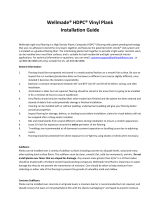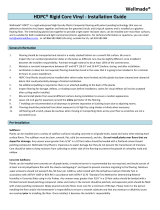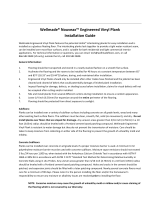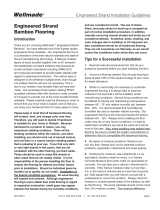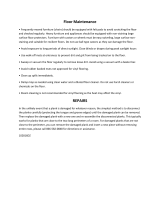
3. Start with a whole plank in the left hand corner of the room with the tongue side and end toward the wall.
Lay the first row of planks along a chalk line and trim to fit to the wall allowing a 3/8 inch (6.35mm)
expansion space. If starting the first row with a whole width plank it will be necessary to trim the tongues
next to the wall, then place the cut ends next to the wall using spacers. To trim the planks, a table saw
works best for both end and length cuts.
4. Align and attach the end joints of the planks in the first row using the fold down method, tap the surface
using a block to lock the joints securely. For length joints insert the tongue into the groove while holding
the plank at a 20° to 30° angle to the floor. Apply pressure inward and down until the planks lock together,
you may use additional tapping if necessary. Use spacers between the long edge and end of the planks
next to the wall to maintain the expansion space.
5. Start the second row using 1/3rd of a plank. Place the cut end against the wall. Insert the tongue on the
long side of the plank into the groove of the plank in the first row. Hold the plank in a 20° to 30° angle
while applying pressure inward and down until they lock together. To complete the second and all
successive rows, it will be necessary to align the short end onto the previous plank first before locking the
long side of the plank. Angle the plank and push the tongue into the groove and adjust it until the tongue
locks into place. It may be necessary to tap the planks inward to lock the joint together. Complete the
second row allowing 3/8 inch expansion space at the start and end of each row.
6. Start the third row using a 2/3rd length of a plank with the cut end against the wall. Complete each row
thereafter using a random layout with end joints off-set by at least 8”. Plan the layout to avoid using small
planks (less than 6”) at the walls and stagger the end joints 6 to 8 inches. The cut piece at the end of the
row can often be used to start the next row provided it achieves a random layout. Always place the cut
end against the wall and allow for the expansion space. There should never be a cut piece in the field of
the installed area, all cuts are along the perimeter.
7. Wellmade HDPC Planks are unique in that they can also be installed using a tapping block and rubber
mallet or hammer and pull bar in difficult areas such as the last row and when fitting under door trim.
Always use a pull bar on the cut edge of the plank, factory edges can be damaged if the pull bar is used
directly against them.
8. When fitting around door trim it will be necessary to slide the plank under the trim. This can be
accomplished easily by starting the row on the side of the room with the door trim and then sliding the
plank into place once it is attached. The row can be completed by inserting the tongue onto the groove or
the groove under the tongue depending on the direction. A tapping block and pull bar (Diagrams 2a & 2b)
can also be used to lock the joints together while the planks are in a flat position. Use a series of light taps
until the joint is gradually locked together.
Diagram 2a Diagram 2b
Bathrooms: Wellmade HDPC planks and be installed in full and half bathrooms. When Wellmade HDPC®
Planks are installed in a bathroom, remember that wood and water do not get along and to avoid
standing water if possible. The flooring should be installed around the toilet leaving a 1/8 inch (3.175mm)
expansion space. Use 100% silicone caulking to fill the expansion space at the toilet, tub, shower, and all
wet areas to help prevent surface water seepage from going under the floor.
Pipes: In rows where there is a pipe or other vertical object through the subfloor, make sure the object
lines up exactly where two boards will meet on the short ends. Take care to measure carefully before
cutting, so the two boards end at the middle of the object. Use a drill or hole bit that is the diameter of






